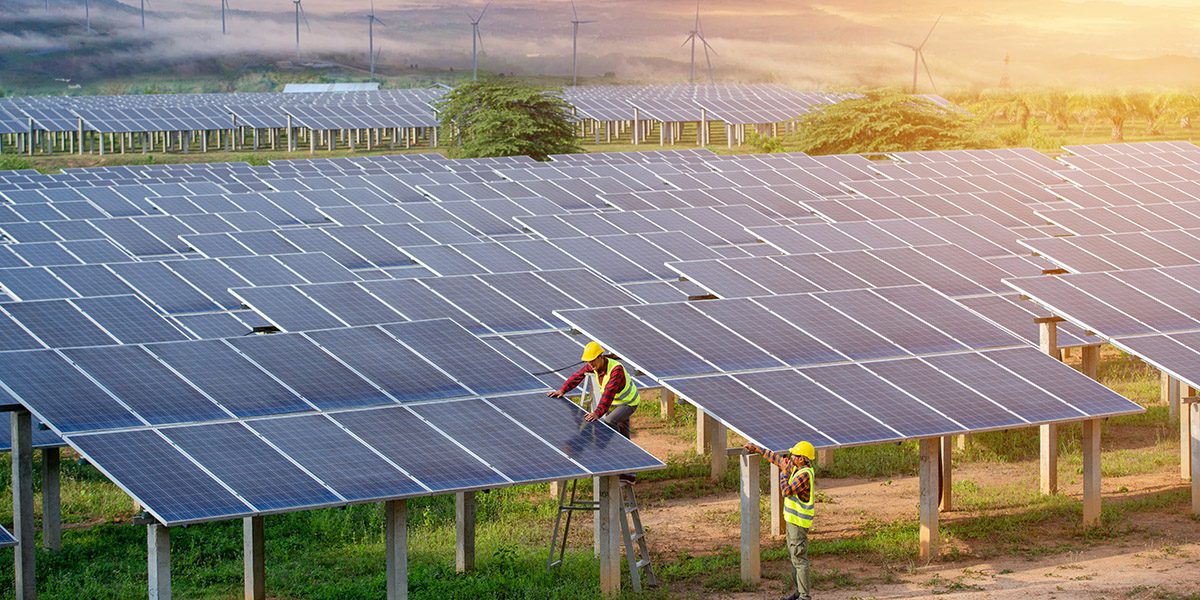“The more things change, the more they stay the same.”

Gary Farha is the CEO and Founder of Coho, an ERM Group Company
When Jean-Baptiste Alphonse Karr wrote these words in 1849, he wasn’t thinking about the world of sustainability in 2023 – but he may as well have been. Ever since our founding 13 years ago, the team at Coho has been amazed by the steadfast and broadening commitment demonstrated by the corporations and institutions (C&I) we work with. Despite the turbulent market forces that influence the options, risks, and decisions that face any entity looking to become more sustainable, we are inspired every year by the continued determination of our clients and partners, and 2023 was no exception.
Since our beginnings, we’ve had the privilege to work with more than 100 large organizations to find their own unique path to meeting climate, energy, and water resiliency goals. This experience has given us a bird’s-eye view of what shapes such challenging journeys and what we might expect in 2024 and beyond. With the year wrapping up, I’d like to use this perspective to offer some thoughts on the markets and clients we serve, by reflecting on the past year and looking forward to the next.
The Overall Sustainability Market
Fortunately, climate-related pursuits have become mainstream for most large corporations and institutions and that is helping drive continued and rapid sustainability market growth. Some indicators of this:
- Many organizations don’t yet have a cohesive climate plan to address their targets, but are working on accounting for their GHG emissions to lay the groundwork to address all three emissions Scopes.
- Many companies in virtually every sector of the economy have just begun their transition to renewable energy and are looking for onsite and offsite projects to meet their needs.
- A growing number of companies are asking about Scope 3 solutions, seeking advice on how to address their supply chains, and joining coalitions such as the Clean Energy Procurement Academy to help them get started. Some are even hosting their first-ever supply chain forums.
- We’re seeing a significant increase in interest in how to address long-term water use, and existing Coho/ERM clients are keen to bring this topic to the conversation.
Accordingly, the advisory market is growing and adapting to this demand.
- Acquisitions/strategic collaborations are increasing in the marketplace. For example, ERM – the world’s largest pure play sustainability consulting firm – acquired Coho in February. The rationale was strong for both organizations – ERM was able to deepen its existing advisory services while Coho gained access to a broader set of large corporations interested in global access to the full range of Coho’s services. KPMG acquired Zurich Resilience Solutions and Edison Energy acquired Alfa Energy to expand their service offerings. Other mainstream consultants including McKinsey, EY, BCG, have added climate, energy transition, and ESG to their services while also growing through acquisitions.
- Advisors are adding people and offices in key parts of the globe. In addition to the large consultancies mentioned above that are adding people and capabilities in sustainability, the combined force of ERM and Coho now represents more than 8,000 experts around the world who will be able to better serve multinationals and create greater impact (e.g., in Europe, Asia).
The demand for sustainability services will continue to increase in 2024, as more companies must adapt to the new climate-focused economic and social landscape, but challenges remain. Chris O’Brien, Coho’s VP of Business Development has observed, “The market will become even more crowded with buyers, while the most widely appealing solutions like offsite renewable energy virtual power purchase agreements (VPPAs), are still bottlenecked.” In the year ahead:
- Many buyers will need external resources to navigate the myriad complexities of the renewable energy market.
- From data collection and reporting to addressing energy, carbon, transport, food and buildings, new technologies will continue to appear on the market.
- The juxtaposition of the climate crisis and the world’s response to it will continue. As summarized by the 2024 Economist Intelligence outlook:
“The year—expected to be the hottest on record—will focus minds on efforts to reduce emissions, rebooting investment into renewables and electric vehicles (EVs). It will also increase demand for products to minimize the effects of climate change, such as air conditioning and the electricity needed to power it. However, governments and companies will mostly fail to reach the ambitious targets that they have set themselves on emissions: global use of fossil fuels will increase. The costs of coping with climate change will become increasingly onerous, not just for sectors directly affected (such as airlines, healthcare, insurance and food production) but also for many companies and governments.”
Coho’s Service Lines
Against the backdrop of this global environment, Coho will continue to support more organizations embarking on or continuing their sustainability efforts. Our three main areas of service and support will each have their own character in the year ahead.

Climate
The year 2023 experienced the hottest summer on record; it also saw a record number of businesses and organizations seeking to enact meaningful climate impact. During Coho’s past year, a few main areas of activity and interest emerged.
Regulatory and policy support
The Inflation Reduction Act (IRA) benefits started to flow, allowing action in areas such as the transition to electric vehicles. The SEC’s proposed disclosure rule could require public companies in the US to share their emissions, physical and transition climate risk exposure, and any targets or transition plans in place. The European Commission’s CSRD rule was made final and makes similar requirements for EU companies and US companies with significant business in the EU, among others.
Looking ahead to 2024, we expect clarity on many marquee IRA benefits, such as those for green hydrogen (which should open stalled markets and increase decarbonization options). Importantly, once the SEC rule is finalized, look for it (along with CSRD requirements) to push corporate executives to communicate how climate ties in with more traditional areas of investor focus, such as finance and strategy.
Institutional action
This year, more organizations shifted toward planning and action on scope 1 and scope 3 emissions. Those who have done so fall into three groups:
- Decarbonization leaders who’ve made progress on scope 2 and are ready for the next step.
- Organizations earlier in their journey exploring a fuller set of decarbonization tools for near-term action in a tightening renewable energy market.
- Organizations setting SBTi-aligned goals, which require addressing all scopes.
We expect this trend to amplify through next year as the abovementioned disclosure rules take hold. Within scopes 1 and 3, we expect to see concentrated action in specific areas, like thermal and fleet electrification, efficiency measures, and supplier engagement programs.
The cost of meeting targets
This year, rising renewable energy prices brought into sharp focus the desire to understand the total cost of meeting sustainability goals, especially those set for 2030. Organizations are looking to communicate the cost not only of near-term solutions that will move the ball forward, but the total cost of decarbonization across scopes – and at a relatively granular level. Beyond simply defining cost, a detailed description of the benefits of meeting targets is key to unlocking action across stakeholder groups and helping senior leaders understand decarbonization’s full value.
All in all, these trends point to deeper integration of corporate climate action in 2024 and a wider set of solutions to explore.

Energy
The past year has been difficult for the renewable energy industry in general, following on three years prior that included an ongoing pandemic and its myriad impacts. Notwithstanding these challenges, corporate demand for renewable energy remained high, if somewhat slower. We’ve seen no major changes in climate ambition, but some organizations have taken their foot off the accelerator a bit, waiting to see if the market improves while still acting on attractive deals as they appear.
As supply chain production and shipping recovered in 2023, other challenges emerged:
- Higher PPA prices and more frequent price changes due to input cost uncertainty
- Lower wholesale market revenues from RE project output
- Interconnection queue dysfunction
- Significantly higher cost of financing for both debt and tax equity (the latter due to uncertainty over potential new capital reserve requirements)
Going into 2024, we see some renewable energy tailwinds:
- The declining cost of inputs for renewable energy equipment (particularly solar) over the past 5-6 months
- The expected loosening and reform of the interconnection logjam over the next 2-3 years
- Electricity and natural gas forwards that suggest improving wholesale energy market revenues
- Rapidly expanding tax credit transferability in the US, that should invite more players and liquidity to market
The implication of these changes is that most organizations looking to improve their Scope 2 emissions can continue to be active participants in the renewable energy markets in 2024. They can also look for opportunities to capture savings in traditional retail power and natural gas markets as they make an integrated transition to renewables.
The retail power and natural gas markets were also volatile, but due to the current state of the market, now is a great time to secure future start contracts. There are several reasons for this:
- Prices dropped coming out of the ‘22/’23 winter months due to:
- A milder than expected winter
- natural gas storage above the 5-year average
- natural gas production levels above the 5-year average (production outpaced demand)
- Prices generally remained lower throughout 2023 when compared to years 2021 and 2022
- Customers procuring power and/or natural gas contracts in 2023 likely saw increased costs if their contract had been executed prior to 2021, but achieved savings with this new contract if their prior one was executed during 2021 or 2022
- Current market indicators illustrate prices will increase in 2024
- U.S. exports will remain high largely due to the Russian-Ukraine conflict, reducing domestic supply
- In some markets, the number of generating units scheduled to come online will likely be outpaced by the number of units going offline
- As a result, now is a good time to lock in future start retail power and gas contracts to take advantage of current prices and mitigate the risk of future price increases

Water
In stark terms, water scarcity is poised to reshape the economic geography of the US. Underestimating water’s impact on business continuity is leaving organizations across all industries vulnerable to significant costs, stakeholder backlash, and production interruptions. Recent trends in the water market include:
- shrinking volume of quality water for business operations
- increasing extreme weather events such as flooding
- strengthening regulatory constraints on wastewater
- growing focus on water accountability for public corporate disclosure
- worsening public perception of corporate water practices
- diversifying supply chains with complex footprints
For many businesses, the potential financial impacts of water risk – when understood at a broader and deeper level – can be far greater than the costs of addressing it. In a sense, water is “the next carbon” for resiliency, sustainability, and disclosure.
In 2023, Coho saw significant client interactions and engagements around water:
- We executed our first Water Processing Agreement (WPA), which reduced the client’s site water footprint by 68% (millions of gallons/year) and leveraged a 3rd party developer’s support and capital.
- We secured our first international water client in conjunction with ERM, including implementing a supply chain water program and addressing a total water footprint of >20B gallons/year for mining, enclosure, chips, glass, and assembly.
- We implemented a first engagement within the oil and gas industry, which included supporting evaluation of multi-hundred million dollar projects for produced water reuse and sale and addressing a single-site wastewater footprint of >2B gallons/year.
- We maintained and expanded service for several Coho/ERM clients, and secured a strategic partnership agreement with Arcadia with direct access to water consumption data across 200+ potential clients.
This work has helped bring to light not only the increasing urgency around water use and mitigation but also barriers that can limit action on water, including a lack of precedent, dedicated internal resources and funding, and executive sponsorship. These factors make it challenging to develop a unified, cross-functional water strategy, and to make progress on water targets.
An important Coho goal for 2024 will be to accelerate the growth of comprehensive water services by adopting a unified approach with ERM — an end-to-end offering to support the planning and implementation necessary for organizations to achieve breakthroughs in the less visible yet critical area of water use and resiliency.
* * *
As the end of 2023 approaches, I am personally grateful for the incredible commitment of both Coho clients and team members to navigating their decarbonization, energy and water journeys. I’m also very appreciative of the confidence ERM has shown in Coho since we joined forces in February. We share a genuine excitement to jointly grow our impact on clients and in turn our planet’s well-being. While it’s clear the path to sustainability success will continue to evolve and change, Coho’s steadfast commitment to putting the client’s interests first will always remain the same.
With best wishes for a bright and fulfilling new year,
Gary Farha
Founder & CEO

